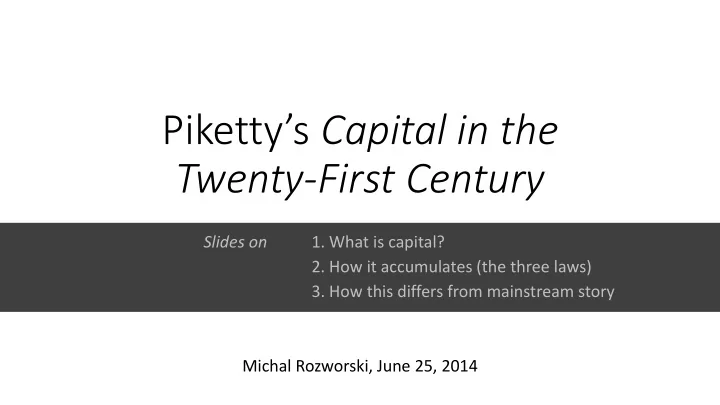

Piketty’s Capital in the Twenty-First Century Slides on 1. What is capital? 2. How it accumulates (the three laws) 3. How this differs from mainstream story Michal Rozworski, June 25, 2014
What is capital? “ I define “national capital” or “national wealth” as the total market value of everything owned by the residents of a country at a given point in time, provided that it can be traded on some market…the sum of non - financial assets (land, dwellings, inventory, machinery…) and financial ” assets (bank accounts, mutual funds, stocks, bonds…). [48] • Other possibilities: • Only productive capacity (mainstream) quantitative difference • Social relation between people, not things qualitative difference
What is capital (good for)? “ Capital fulfills two economics functions: first, it provides housing…and second, it serves as a factor of production in producing other goods and services. Historically, the earliest forms of capital accumulation involved ” both tools and improvements to land and rudimentary dwellings. • Economic function • Factor of production (e.g. of housing services) • Store of value • Anthropological roots
How capital accumulates • Stylized facts overlaid with theory • Three Fundamental “Laws” (not quite) • Long-run values and ranges based on empirical data gathering project • Savings rate, s : ~10% (+/-) • Return on capital, r : 4-5% 3-4% • Growth rate, g : 1-2% • Capital-income ratio (relative amount of capital), β , varies widely • Under capitalism so far: 200% to 700%
Law 1: 𝛽 ≡ 𝑠 × 𝛾 𝐷𝑏𝑞𝑗𝑢𝑏𝑚 𝑗𝑜𝑑𝑝𝑛𝑓 𝑡ℎ𝑏𝑠𝑓 ≡ 𝑠𝑏𝑢𝑓 𝑝𝑔 𝑠𝑓𝑢𝑣𝑠𝑜 × 𝑑𝑏𝑞𝑗𝑢𝑏𝑚 𝑗𝑜𝑑𝑝𝑛𝑓 𝑠𝑏𝑢𝑗𝑝 • What is it? Accounting identity, true by definition • Why does it matter? Undermines mainstream (neoclassical) stylized fact of stable capital share • Capital can take a greater or smaller cut
Law 2: 𝛾 = 𝑡 𝐷𝑏𝑞𝑗𝑢𝑏𝑚 𝑗𝑜𝑑𝑝𝑛𝑓 𝑠𝑏𝑢𝑗𝑝 𝐷𝑏𝑞𝑗𝑢𝑏𝑚 = 𝑡𝑏𝑤𝑗𝑜𝑡 𝑠𝑏𝑢𝑓 𝑠𝑏𝑢𝑓 𝑝𝑔 𝑠𝑝𝑥𝑢ℎ • What is it? “Asymptotic law”, or long -run tendency (with adjustment) • Why does it matter? Describes how capital can accumulate if growth falls back after post-war reconstruction and global South catch-up
Law 3: 𝑠 > 𝑠𝑏𝑢𝑓 𝑝𝑔 𝑠𝑓𝑢𝑣𝑠𝑜 𝑓𝑦𝑑𝑓𝑓𝑒𝑡 𝑢ℎ𝑓 𝑠𝑝𝑥𝑢ℎ 𝑠𝑏𝑢𝑓 • What is it? Observed inequality throughout human history • Why does it matter? Another tendency towards wealth concentration “ The inequality r > g in one sense implies that the past tends to devour the future : wealth originating in the past automatically grows more ” rapidly, even without labor, than wealth stemming from work… [378]
Law 3: 𝑠 > Source: Piketty, Capital in the 21 st -Century , Fig. 10.10 [356]
Law 3: 𝑠 > Source: Piketty, Capital in the 21 st -Century , Fig. 10.11 [357]
Mechanisms for rising inequality • Social, psychological factors • But s and r both higher for already-wealthy • Increasing effect the larger your initial wealth
Mechanisms for rising inequality Source: Saez and Zucman, http://gabriel-zucman.eu/files/SaezZucman2014Slides.pdf
Mechanisms for rising inequality • Social, psychological factors • But s and r both higher for already-wealthy • Increasing effect the larger your initial wealth • Globalized and flexible financial markets • Financial as important as technical engineering for capital’s bargaining power • Inheritance as a good in itself
From optimism… Source: Piketty, Capital in the 21 st -Century , Fig. 8.5 [291]
From optimism…to pessimism Source: Piketty, Capital in the 21 st -Century , Fig. 8.5 [291]
From neoclassical economics… • Balanced growth path and long-term tendency towards equilibrium • Stability, even of bad outcomes • Growth population and technology • Not much of a role for finance and crisis • Real-economy story that ignores financial instabilities and credit
…to classical political economy • “Simple” math and critique of abstract models Form • Literary style • Historical data to form conclusions • Social conflict over distribution Content • Divorced from individual (+) and from production (-) • Wealth transmission rather than consumption smoothing • Divergence rather than convergence
Example: why is r stable? • Controversy over elasticity of capital • Elasticity > 1: capital can easily replace labour • Combine with increase in capital’s bargaining power growing inequality “ …no self -corrective mechanism exists to prevent a steady increase of the ” capital/income ratio…[and] capital’s share of income. • Institutions matter • But how do they arise, evolve and fall • Going beyond catastrophic events like war for social explanation
Avenues going forward Two sociological observations to be explained: 1. The “ supermanagers ”: labouring capitalists 2. The “patrimonial middle class”: a split in the working class • Drawn into the orbit of wealth accumulation largely through housing One large, barely initiated methodological rupture: • A return to political economy 1. Power 2. Politics Piketty’s focus 3. Production
Open wide…
Recommend
More recommend